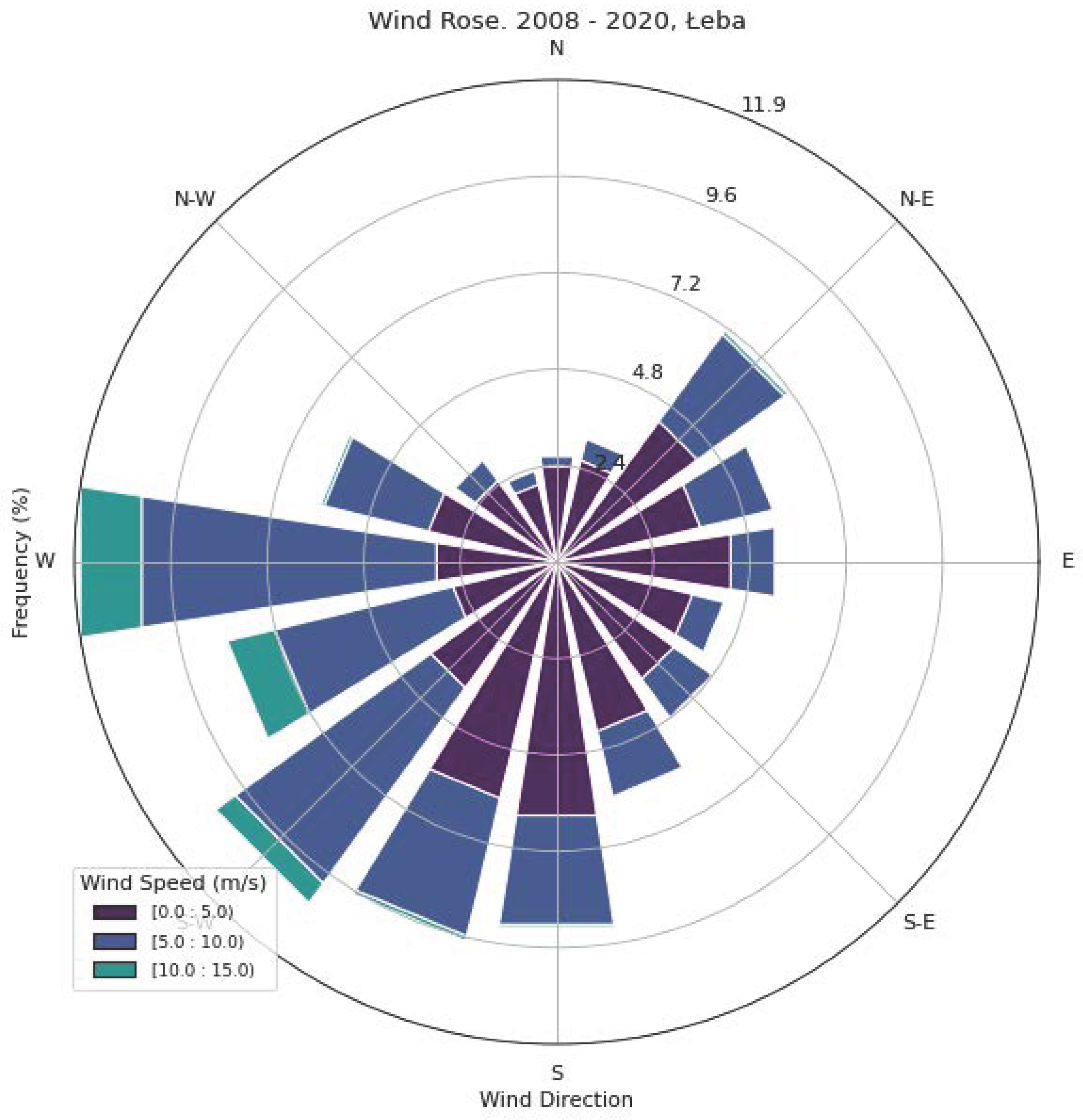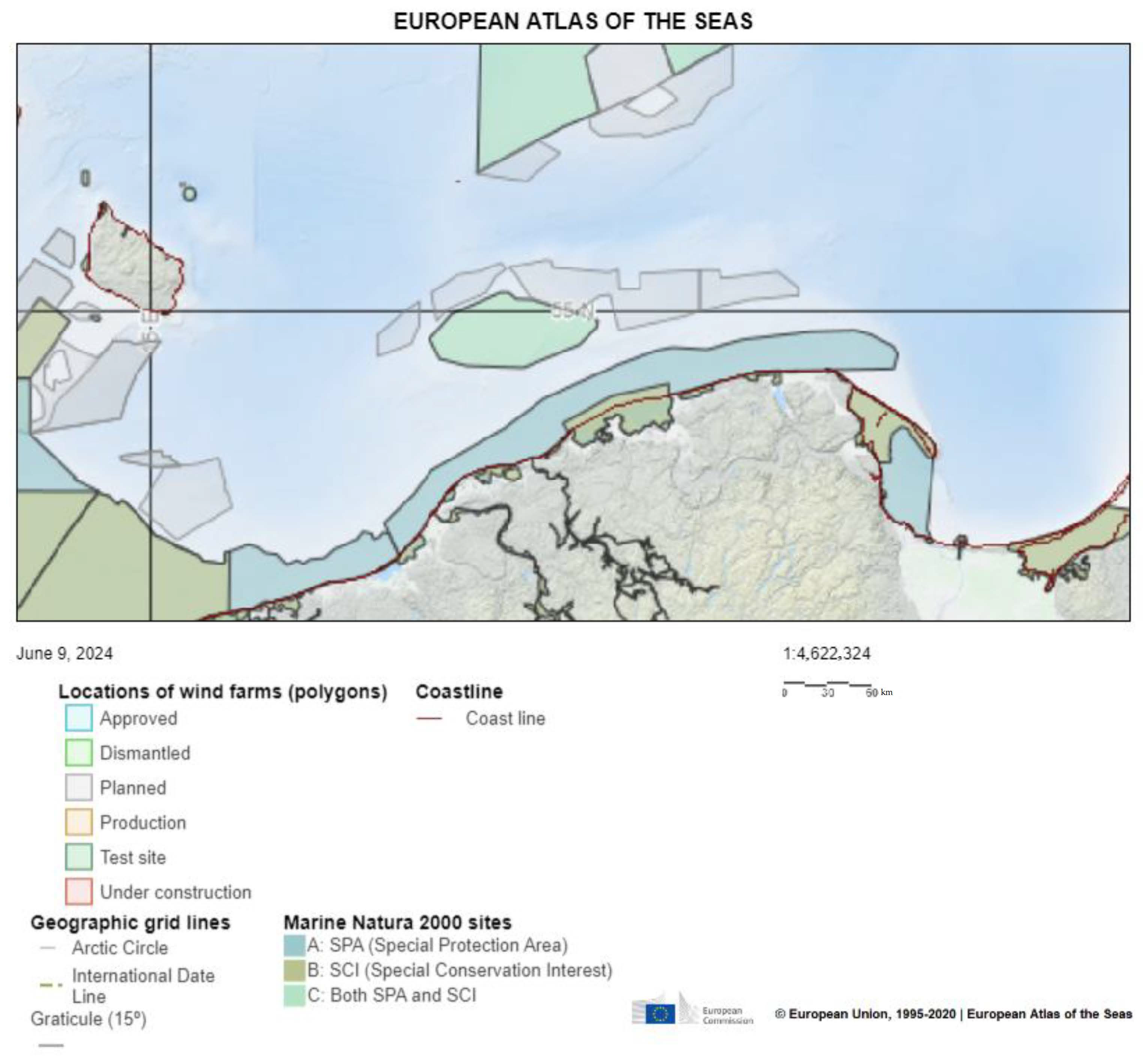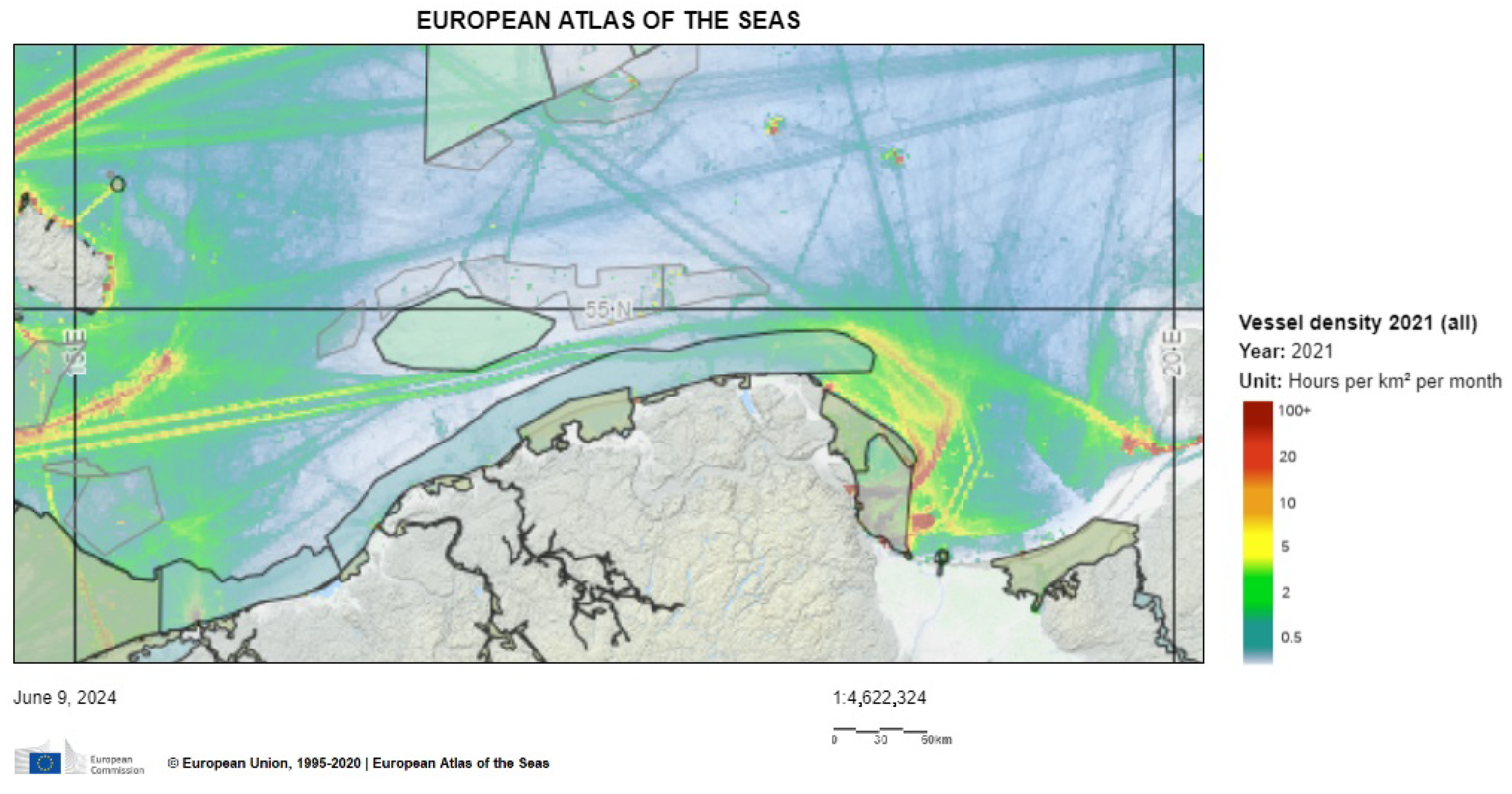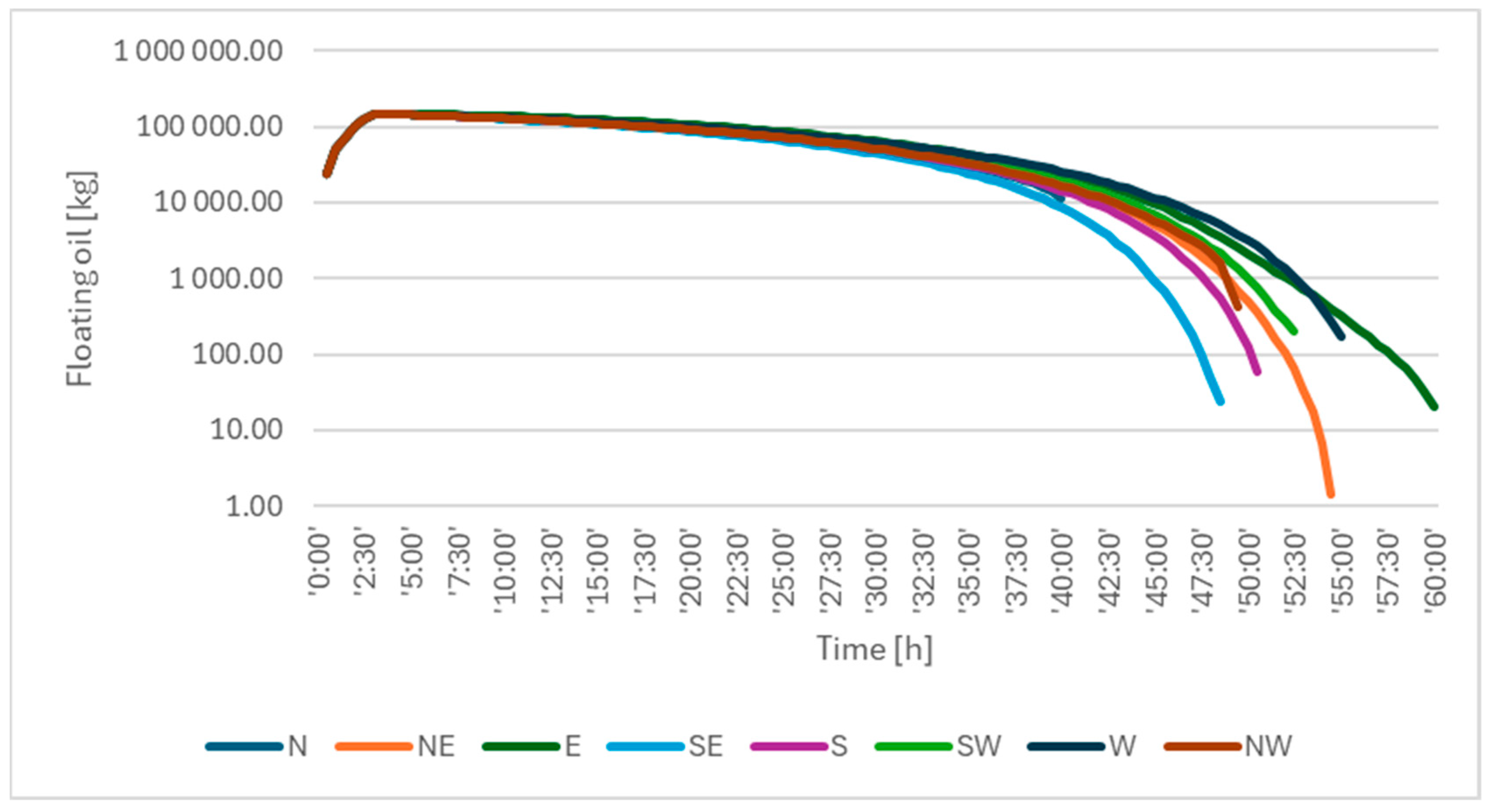Analysis of the Impact of Wind Farm Construction on the Marine Environment
Abstract
:1. Introduction
2. Materials and Methods
2.1. Offshore Wind Farms in Poland
- Baltica-1 wind power plant with a capacity of up to 896 MW (by 2030);
- Baltica-2 wind power plant, with a capacity of up to 1498 MW (by 2030);
- Baltica-3 wind power plant with a capacity of up to 1045 MW (after 2030).
2.2. Area of Study
2.2.1. Hydrometeorological Conditions
- winds;
- currents;
- visibility and fog;
- flooding.
Wind
Sea Currents and Wave Action
Visibility
Flooding
2.2.2. Specially Protected Areas
- areas of Natura 2000;
- nature reserves;
- landscape parks;
- protected landscape areas;
- national parks.
- PLC 990,001 Slupsk Bank;
- PLB 990,002 The coastal waters of the Baltic Sea;
- PLB 220,003 Slovenian coast.
Slupsk Bank
- Habitats:
- ○
- submarine sandbanks (code 1110);
- ○
- rocky and stony seabed, reefs (code 1170).
- Bird species:
- ○
- black guillemot (Cepphus grylle), (code A202);
- ○
- long-tailed duck (Clangula hyemalis), (code A064);
- ○
- red-throated Loon (Gavia stellata), (code A001);
- ○
- black-throated Loon (Gavia arctica), (code A002).
Coastal Waters of the Baltic Sea
Słowińskie Coast
2.2.3. Ship Traffic in the Area
TSS Słupska Bank
- Western part:
- ○
- two traffic lanes, each 1.75 miles wide;
- ○
- a separation zone 0.5 miles wide.
- Central part:
- ○
- two traffic lanes, each 1.6 miles wide;
- ○
- a traffic separation zone 0.4 miles wide on the western side and 0.8 miles wide on the eastern side;
- ○
- a coastal traffic zone.
- Eastern part:
- ○
- two traffic lanes of variable width;
- ○
- a traffic separation zone of variable shape and width;
- ○
- a coastal traffic zone.
- conducting the control and management of ship traffic through issuing instructions, recommendations, and orders, especially when, in the VTS operator’s assessment, the situation may lead to a threat to navigation safety;
- overseeing compliance with traffic regulations and other rules applicable to designated transit routes and in the traffic separation system;
- utilising available radar systems, communication devices, and the Automatic Identification System (AIS) to provide an information service in the area.
Traffic on Shipping Routes
2.3. Hazardous Substances in Offshore Wind Farms
2.3.1. Hazardous Substances in Offshore Wind Turbines
- a cooling fluid to prevent the cooling system from freezing;
- gear oil for lubricating the gearbox and all bearings of the drive system (including generator bearings and main bearings);
- hydraulic oil for blade pitch control, brake operation, service lift, and rotational gearbox;
- oil in the high-voltage (HV) transformer;
- gas in the high-voltage switchgear;
- lithium iron phosphate (LiFePO4) batteries used for energy storage to maintain power supply.
- Gear oil, hydraulic oil, or coolant leaking within the nacelle are captured at the bottom of the nacelle cover;
- Hydraulic oil leaking inside the hub is captured within the hub;
- Hydraulic oil leaking beyond the hub plate is captured by the blade shaft;
- Coolant leaking from the upper part of the radiator may not be secured against entering the environment. This issue is mitigated by selecting the type of coolant;
- Oil from the HV transformer is captured in the lower part of the nacelle cover;
- Grease for the external pitch system gearbox will be collected in the pitch interface section.
2.3.2. Potential for Spills Due to Structural Failure
- striking a vessel in drift or en route into the base of a wind turbine and damaging the hull resulting in the spillage of marine fuel;
- an oil tanker striking the base of a wind turbine while adrift or en route and causing hull damage resulting in spillage of the tanker’s cargo;
- an oil tanker striking a turbine and causing the nacelle to fall onto the tanker and cause a fire resulting in a spillage of oil;
- turbine gear oil spill while being replaced;
- turbine fire and contaminant spill;
- contaminant spill into the sea during construction and servicing operations;
- structural failure.
2.4. Methodology
3. Results
3.1. Simulations
- for a wind farm with one substation and 25 wind turbines: 57,500 litres of oil;
- for a wind farm with two substations and 100 wind turbines: 152,500 litres of oil.
3.2. Limitations
4. Discussion
Funding
Data Availability Statement
Conflicts of Interest
References
- Bejarano, A.C.; Michel, J.; Rowe, J.; Li, Z.; McCay, D.F.; McStay, L.; Etkin, D.S. Environmental Risks, Fate, and Effects of Chemicals Associated with Wind Turbines on the Atlantic Outer Continental Shelf; OCS Study BOEM; US Department of the Interior, Bureau of Ocean Energy Management, Office of Renewable Energy Programs: Herndon, VA, USA, 2013; p. 213.
- Gunter, C.T. Potential Impacts from a Worst Case Discharge from an United States Offshore Wind Farm. Int. Oil Spill Conf. Proc. 2014, 2014, 869–877. [Google Scholar] [CrossRef]
- Etkin, D.S. Oil Spill Risk Analysis for Cape Wind Energy Project. Int. Oil Spill Conf. Proc. 2008, 2008, 571–579. [Google Scholar] [CrossRef]
- Bela, A.; Le Sourne, H.; Buldgen, L.; Rigo, P. Ship Collision Analysis on Offshore Wind Turbine Monopile Foundations. Mar. Struct. 2017, 51, 220–241. [Google Scholar] [CrossRef]
- Chen, X.; Xu, J.Z. Structural Failure Analysis of Wind Turbines Impacted by Super Typhoon Usagi. Eng. Fail. Anal. 2016, 60, 391–404. [Google Scholar] [CrossRef]
- Moulas, D.; Shafiee, M.; Mehmanparast, A. Damage Analysis of Ship Collisions with Offshore Wind Turbine Foundations. Ocean Eng. 2017, 143, 149–162. [Google Scholar] [CrossRef]
- Liu, C.; Hao, E.; Zhang, S. Optimization and Application of a Crashworthy Device for the Monopile Offshore Wind Turbine against Ship Impact. Appl. Ocean Res. 2015, 51, 129–137. [Google Scholar] [CrossRef]
- Cho, B.I.; Kim, D.H. Fragility Assessment of Offshore Wind Turbine by Ship Collision. J. Korean Soc. Coast. Ocean Eng. 2013, 25, 236–243. [Google Scholar] [CrossRef]
- Mo, R.; Li, M.; Kang, H. Transient Behaviour of Grouted Connections of Offshore Wind Turbines Subject to Ship Impact. Appl. Ocean Res. 2018, 76, 159–173. [Google Scholar] [CrossRef]
- Kirchgeorg, T.; Weinberg, I.; Hörnig, M.; Baier, R.; Schmid, M.J.; Brockmeyer, B. Emissions from Corrosion Protection Systems of Offshore Wind Farms: Evaluation of the Potential Impact on the Marine Environment. Mar. Pollut. Bull. 2018, 136, 257–268. [Google Scholar] [CrossRef] [PubMed]
- Uadiale, S.; Urbán, E.; Carvel, R.; Lange, D.; Rein, G. Overview of Problems and Solutions in Fire Protection Engineering of Wind Turbines. Fire Saf. Sci. 2014, 11, 983–995. [Google Scholar] [CrossRef]
- Rengel, B.; Pastor, E.; Hermida, D.; Gómez, E.; Molinelli, L.; Planas, E. Computational Analysis of Fire Dynamics Inside a Wind Turbine. Fire Technol. 2017, 53, 1933–1942. [Google Scholar] [CrossRef]
- Barkley, W.C.; Jacobs, L.D.; Rutherford, M.C. Structural Health Monitoring of Wind Turbine Blades. In Proceedings of the ASME 2009 3rd International Conference on Energy Sustainability Collocated with the Heat Transfer and InterPACK09 Conferences, San Francisco, CA, USA, 19–23 July 2009; pp. 1047–1058. [Google Scholar]
- Program Rozwoju Morskich Farm Wiatrowych—Morska Energetyka Wiatrowa—Portal Gov.pl. Available online: https://www.gov.pl/web/morska-energetyka-wiatrowa/program-rozwoju-morskich-farm-wiatrowych (accessed on 2 November 2023).
- PGE Polish Energy Group. Morska Farma Wiatrowa Baltica 1 z Warunkami Przyłączenia do Sieci Przesyłowej. Available online: https://www.gkpge.pl/grupa-pge/dla-mediow/komunikaty-prasowe/korporacyjne/morska-farma-wiatrowa-baltica-1-z-warunkami-przylaczenia-do-sieci-przesylowej (accessed on 15 November 2023).
- Baltica 2+3. Available online: https://baltica.energy/pl-pl/baltica-two-and-three (accessed on 26 February 2024).
- Baltic Power. Available online: https://balticpower.pl/o-projekcie/ (accessed on 2 November 2023).
- Ocean Winds—Generujemy Przyszłość Morskiej Energii Wiatrowej. Available online: https://www.bc-wind.pl/ (accessed on 15 November 2023).
- FEW Baltic II. Available online: https://fewbalticii.rwe.com/pl-PL (accessed on 2 November 2023).
- MFW Bałtyk II. Available online: https://www.baltyk2.pl/ (accessed on 15 November 2023).
- MFW Bałtyk III. Available online: https://www.baltyk3.pl/ (accessed on 15 November 2023).
- MFW Bałtyk I. Available online: https://www.mfwbaltyk1.pl/ (accessed on 2 November 2023).
- UK Hydrographic Office. Baltic Pilot Vol II NP19; United Kingdom Hydrographic Office: Taunton, UK, 2005; Volume II.
- UK Hydrographic Office. Baltic Pilot Volume I NP18, 13th ed.; United Kingdom Hydrographic Office: Taunton, UK, 2004.
- Sulisz, W.; Paprota, M.; Reda, A. Extreme Waves in the Southern Baltic Sea. Cienc. Mar. 2016, 42, 123–137. [Google Scholar] [CrossRef]
- Ida Stanisławczyk The Ice Winter 2015/2016 on the Polish Baltic Sea Coast; IMGW. Available online: https://baltyk.imgw.pl//index.php?page=22&subpage=90 (accessed on 2 November 2023).
- Ida Stanisławczyk The Ice Winter 2016/17 on the Polish Baltic Sea Coast; IMGW. Available online: https://baltyk.imgw.pl//index.php?page=22&subpage=90 (accessed on 2 November 2023).
- Ida Stanisławczyk The Ice Winter 2017/18 on the Polish Baltic Sea Coast; IMGW. Available online: https://baltyk.imgw.pl//index.php?page=22&subpage=90 (accessed on 2 November 2023).
- Ida Stanisławczyk The Ice Winter 2018/19 on the Polish Baltic Sea Coast; IMGW. Available online: https://baltyk.imgw.pl//index.php?page=22&subpage=90 (accessed on 2 November 2023).
- Ida Stanisławczyk The Ice Winter 2019/2020 on the Polish Baltic Sea Coast; IMGW. Available online: https://baltyk.imgw.pl//index.php?page=22&subpage=90 (accessed on 2 November 2023).
- Hydrologia | Nasz Bałtyk. Available online: https://naszbaltyk.pl/hydrologia/ (accessed on 2 November 2023).
- What You Should Know about the Baltic Sea. Available online: https://naturalniebaltyckie.pl/en/education/what-you-should-know-about-the-baltic-sea (accessed on 19 March 2024).
- Wibig, J.; Jakusik, E. (Eds.) Warunki Klimatyczne i Oceanograficzne w Polsce i na Bałtyku Południowym: Spodziewane Zmiany i Wytyczne do Opracowania Strategii Adaptacyjnych w Gospodarce Krajowej; Wpływ zmian klimatu na środowisko, gospodarkę i społeczeństwo: Zmiany, skutki i sposoby ich ograniczenia, wnioski dla nauki, praktyki inżynierskiej i planowania gospodarczego; Instytut Meteorologii i Gospodarki Wodnej—Państwowy Instytut Badawczy: Warszawa, Poland, 2012; ISBN 978-83-61102-65-6. [Google Scholar]
- Klimat w Polsce—Portal Klimat IMGW-PiB. Available online: https://klimat.imgw.pl/ (accessed on 19 March 2024).
- Water Temperature in Baltic Sea Today. Available online: https://seatemperature.info/baltic-sea-water-temperature.html (accessed on 19 March 2024).
- Obszary Natura 2000. Available online: http://ine.eko.org.pl/index_areas.php?rek=33 (accessed on 19 March 2024).
- European Atlas of the Seas. Available online: https://ec.europa.eu/maritimeaffairs/atlas/maritime_atlas/#lang=EN;p=w;bkgd=5;theme=913:0.75;c=1920397.1042340684,7485207.929468844;z=7 (accessed on 17 May 2024).
- Obszary Natura 2000. Available online: http://www.ine.eko.org.pl/index_areas.php?rek=63 (accessed on 19 March 2024).
- Słowiński Park Narodowy. Available online: https://spn.gov.pl/# (accessed on 19 March 2024).
- Tchakoua, P.; Wamkeue, R.; Ouhrouche, M.; Slaoui-Hasnaoui, F.; Tameghe, T.; Ekemb, G. Wind Turbine Condition Monitoring: State-of-the-Art Review, New Trends, and Future Challenges. Energies 2014, 7, 2595–2630. [Google Scholar] [CrossRef]
- Tchakoua, P.; Wamkeue, R.; Tameghe, T.A.; Ekemb, G. A Review of Concepts and Methods for Wind Turbines Condition Monitoring. In Proceedings of the 2013 World Congress on Computer and Information Technology (WCCIT), Sousse, Tunisia, 22–24 June 2013; pp. 1–9. [Google Scholar]
- Amirat, Y.; Benbouzid, M.; Bensaker, B.; Wamkeue, R. Condition Monitoring and Fault Diagnosis in Wind Energy Conversion Systems: A Review. In Proceedings of the 2007 IEEE International Electric Machines & Drives Conference, Antalya, Turkey, 3–5 May 2007. [Google Scholar]
- Anderson, F.; Dawid, R.; McMillan, D.; Cava, D.G. On the Sensitivity of Wind Turbine Failure Rate Estimates to Failure Definitions. J. Phys. Conf. Ser. 2023, 2626, 012025. [Google Scholar] [CrossRef]
- Carroll, J.; McDonald, A.; McMillan, D. Failure Rate, Repair Time and Unscheduled O&M Cost Analysis of Offshore Wind Turbines. Wind Energy 2016, 19, 1107–1119. [Google Scholar] [CrossRef]
- Koeller, J.; Koeppel, J.; Peters, W. (Eds.) Offshore Wind Energy: Research on Environmental Impacts, 1st ed.; Springer: New York, NY, USA, 2006; ISBN 978-3-540-34676-0. [Google Scholar]
- Łazuga, K. Testing of an Oil Spill Mathematical Model Contained in PISCES II Simulator. Zesz. Nauk. Akad. Morska Szczecinie 2012, 32, 105–109. [Google Scholar]
- Morska Służba Poszukiwania i Ratownictwa. Krajowy Plan Zwalczania Zagrożeń i Zanieczyszczeń Środowiska Morskiego. 2005. Available online: https://sar.gov.pl/uploads/media/Akty_prawne/0001/05/40c62989359842013a679bb02558d842b440a030.pdf (accessed on 19 March 2024).
- Łazuga, K.; Gucma, L.; Perkovic, M. Optimal Allocation of Response Resources Model Verification on the Example of Oil Spill on the Pomeranian Bay. In Towards Green Marine Technology and Transport: Proceedings of the 16th International Congress of the International Maritime Association of the Mediterranean (IMAM 2015), Pula, Croatia, 21–24 September 2015; CRC Press: Boca Raton, FL, USA, 2015; ISBN 978-1-315-64349-6. [Google Scholar]
- Mentes, A.; Turan, O. A New Resilient Risk Management Model for Offshore Wind Turbine Maintenance. Saf. Sci. 2019, 119, 360–374. [Google Scholar] [CrossRef]










| Lp. | Name of Project and Project Company | Investors | Technical Conditions for Grid Connection to (WTP) | Number of Wind Power Plants | Number of Offshore Substations |
|---|---|---|---|---|---|
| 1 | Baltica 3 Elektrownia Wiatrowa Baltica 3 sp. z o.o. (Warsaw, Poland) | PGE Baltica/Orsted | 1045.5 MW | 80 | 2 |
| 2 | Baltica 2 Elektrownia Wiatrowa Baltica 2 sp. z o.o. (Warsaw, Poland) | PGE Baltica/Orsted | 1498 MW | 100 | 2 |
| 3 | Baltic Power (Warsaw, Poland) | PKN Orlen (Baltic Power sp. z o.o.) | 1200 MW | 76 | 2 |
| 4 | BC-Wind C-Wind Polska sp. z o.o. (Warsaw, Poland) | Ocean Winds | 399 MW | nd | |
| 5 | FEW Baltic II Baltic Trade and Invest sp. z o.o. (Słupsk, Poland) | RWE Renewables | 350 MW | 25 | nd |
| 6 | MFW Bałtyk II MFW Bałtyk II sp. z o.o. (Warsaw, Poland) | Polenergia/Equinor | 720 MW | 60 | 1 |
| 7 | MFW Bałtyk III MFW Bałtyk III sp. z o.o. (Warsaw, Poland) | Polenergia/Equinor | 720 MW | 60 | 1 |
| 8 | Baltica 1 Elektrownia Wiatrowa Baltica-1 sp z o.o. (Warsaw, Poland) | PGE Baltica | 896 MW | nd | nd |
| Minimum | Average | Maximum | |
|---|---|---|---|
| Temperature [°C] | 0.0 | 9.6 | 25.0 |
| Salinity [PSU] | 5.6 | 7.3 | 8.4 |
| Density [kg/m3] | 1002.6 | 1005.3 | 1006.7 |
| Air temp. [°C] | −9.9 | 8.7 | 28.3 |
| Air pressure [Pa] | 96,455 | 101,424 | 104,910 |
| Air density [kg/m3] | 1165 | 1254 | 1379 |
| Relative humidity [%] | 41.3 | 80.8 | 100 |
| LW Solar radiation [W/m2] | 180.0 | 307.5 | 415.2 |
| SW Solar radiation [W/m2] | 0 | 136.8 | 846.1 |
| Hourly precipitation [mm] | 0.0 | 0.1 | 6.9 |
| Lp. | Name of the Area | Type | Location | Area [km2] |
|---|---|---|---|---|
| 1. | Slowinski National Park (Pobrzeze Slowinskie) | National park | Land/sea | 322.8 |
| 2. | Enclosure of the Słowiński National Park | National park enclosure | Land | 284.7 |
| 3. | Babnica Nature Reserve | Reserve | Land | 0.6 |
| 4. | Bialogóra reserve | Reserve | Land | 2.1 |
| 5. | Sarbska Spit Nature Reserve | Reserve | Land | 5.7 |
| 6. | Cape Rozewski Nature Reserve | Reserve | Land | 0.1 |
| 7. | Widovo reserve | Reserve | Land | 1.0 |
| 8. | Seaside Landscape Park | Landscape park | Land | 178.3 |
| 9. | Maritime Protected Landscape Area | Protected landscape area | Land | 142.1 |
| 10. | Białogóra | Natura 2000 area | Land | 11.3 |
| 11. | Kashubian Cliffs | Natura 2000 area | Land | 2.3 |
| 12. | Slupsk Shoal | Natura 2000 area | Sea | 800.5 |
| 13. | Sarbska Spit | Natura 2000 area | Land | 18.8 |
| 14. | Ostoja Słowińska | Natura 2000 area | Land/sea | 329.6 |
| 15. | Piasnica Meadows | Natura 2000 area | Land | 10.8 |
| 16. | Coastal waters of the Baltic Sea | Natura 2000 area | Sea | 1946.3 |
| 17. | Widowo | Natura 2000 area | Land | 1.0 |
| Port/Year | 2010 | 2011 | 2012 | 2013 | 2014 | 2015 | 2016 | 2017 | 2018 | 2019 | 2020 |
| Gdańsk | 3299 | 3252 | 3127 | 2948 | 2869 | 3106 | 3274 | 3465 | 4432 | 3927 | 3490 |
| Gdynia | 4175 | 3864 | 3578 | 3618 | 3754 | 3678 | 3956 | 3966 | 4650 | 4283 | 2566 |
| Władysławowo | 194 | 175 | 165 | 174 | 80 | 78 | 81 | 76 | 98 | 66 | 90 |
| Kłajpeda | 6949 | 7063 | 7329 | 6919 | 6964 | 7058 | 6998 | 6571 | 7081 | 6776 | 6453 |
| Kaliningrad | 5993 | 7098 | 6478 | 7929 | 6566 | 5432 | 5600 | 7128 | 6927 | 4641 | 3848 |
| Sum | 20,610 | 21,452 | 20,677 | 21,588 | 20,233 | 19,352 | 19,909 | 21,206 | 23,188 | 19,693 | 16,447 |
| % in relation to 2010 | 0.0 | 4.1 | 0.3 | 4.7 | −1.8 | −6.1 | −3.4 | 2.9 | 12.5 | −4.5 | −20.2 |
| % year-on-year | 0.0 | 4.1 | −3.6 | 4.4 | −6.3 | −4.4 | 2.9 | 6.5 | 9.3 | −15.1 | −16.5 |
| No | Location | Substance | Volume [L] | Toxicity (Based on SDS-Safety Data Sheets) |
|---|---|---|---|---|
| NACELLE | ||||
| 1 | Yaw pinion lubrication system | Lubricant oil | 40 | Harmful to aquatic organisms, may cause long-term adverse effects in the aquatic environment. |
| 2 | Swivel gear | Gear oil | 12 × 20 | No known significant effects or critical risks. |
| 3 | Lubrication system for main bearings | Smar | 270 | Harmful to aquatic organisms. |
| 4 | Transformator | Ester oil | 6500 | This product is not classified as hazardous. |
| 5 | Coolant | Water/glycol | 1800 | There is a high probability that the product is not seriously harmful to aquatic organisms. |
| SHAFT (GENERATOR) | ||||
| 6 | Hydraulic system | Hydraulic oil | 500 | It is expected to be biodegradable. Bioaccumulation of this product in food chains in the environment is not expected. |
| HUB | ||||
| 7 | Lubrication system for the turbine blade bearings. | Lubricant | 180 | It is expected to be practically non-toxic. |
| 8 | Pitch system hydraulic accumulators | Hydraulic oil | 350 | As above (No. 6). |
| 9 | Pitch system hydraulic accumulators (at 1bar abs) | Azot (Nitrogen) | 63,000 | Hazardous material. |
| TOWER | ||||
| 10 | Damping Liquid | Water/Glycol | 1400 | As above (No. 5). |
| No | Spill Volume [t] | Wind | Current | |
|---|---|---|---|---|
| Direction | Speed [m/s] | Speed [m/s] | ||
| A1 | 150 | N | 30 | 0.15 |
| A2 | 150 | NE | 30 | 0.15 |
| A3 | 150 | E | 30 | 0.15 |
| A4 | 150 | SE | 30 | 0.15 |
| A5 | 150 | S | 30 | 0.15 |
| A6 | 150 | SW | 30 | 0.15 |
| A7 | 150 | W | 30 | 0.15 |
| A8 | 150 | NW | 30 | 0.15 |
| B1 | 150 | N | 7 | 0.1 |
| B2 | 150 | NE | 7 | 0.1 |
| B3 | 150 | E | 7 | 0.1 |
| B4 | 150 | SE | 7 | 0.1 |
| B5 | 150 | S | 7 | 0.1 |
| B6 | 150 | SW | 7 | 0.1 |
| B7 | 150 | W | 7 | 0.1 |
| B8 | 150 | NW | 7 | 0.1 |
| # | Time | Amount Spilled [kg] | Amount Floating [kg] | Amount Evaporated [kg] | Amount Dispersed [kg] | Amount Stranded [kg] | Amount Sunk [kg] | Amount Floating Mixture [kg] | Amount Recovered Mixture [kg] | Max Thickness [mm] | Slick Area [m2] | Viscosity [cSt] |
|---|---|---|---|---|---|---|---|---|---|---|---|---|
| 1 | ‘0:00’ | 0 | 0 | 0 | 0 | 0 | 0 | 0 | 0 | 0 | 0 | |
| 2 | ‘0:30’ | 24,597 | 3808 | 0 | 20,789 | 0 | 0 | 4700 | 0 | 5 | 8473 | 212 |
| 3 | ‘1:00’ | 49,597 | 3894 | 1 | 45,703 | 0 | 0 | 4815 | 0 | 4 | 8521 | 213 |
| 4 | ‘1:30’ | 74,597 | 3851 | 1 | 70,745 | 0 | 0 | 4758 | 0 | 4 | 8662 | 212 |
| 5 | ‘2:00’ | 99,597 | 3875 | 1 | 95,721 | 0 | 0 | 4789 | 0 | 4 | 8380 | 213 |
| 6 | ‘2:30’ | 124,597 | 3801 | 2 | 120,794 | 0 | 0 | 4690 | 0 | 4 | 8537 | 212 |
| 7 | ‘3:00’ | 149,597 | 3797 | 2 | 145,798 | 0 | 0 | 4684 | 0 | 3 | 8377 | 212 |
| 8 | ‘3:30’ | 150,000 | 0 | 2 | 149,998 | 0 | 0 | 0 | 0 | 0 | 0 |
Disclaimer/Publisher’s Note: The statements, opinions and data contained in all publications are solely those of the individual author(s) and contributor(s) and not of MDPI and/or the editor(s). MDPI and/or the editor(s) disclaim responsibility for any injury to people or property resulting from any ideas, methods, instructions or products referred to in the content. |
© 2024 by the author. Licensee MDPI, Basel, Switzerland. This article is an open access article distributed under the terms and conditions of the Creative Commons Attribution (CC BY) license (https://creativecommons.org/licenses/by/4.0/).
Share and Cite
Łazuga, K. Analysis of the Impact of Wind Farm Construction on the Marine Environment. Energies 2024, 17, 3523. https://doi.org/10.3390/en17143523
Łazuga K. Analysis of the Impact of Wind Farm Construction on the Marine Environment. Energies. 2024; 17(14):3523. https://doi.org/10.3390/en17143523
Chicago/Turabian StyleŁazuga, Kinga. 2024. "Analysis of the Impact of Wind Farm Construction on the Marine Environment" Energies 17, no. 14: 3523. https://doi.org/10.3390/en17143523






